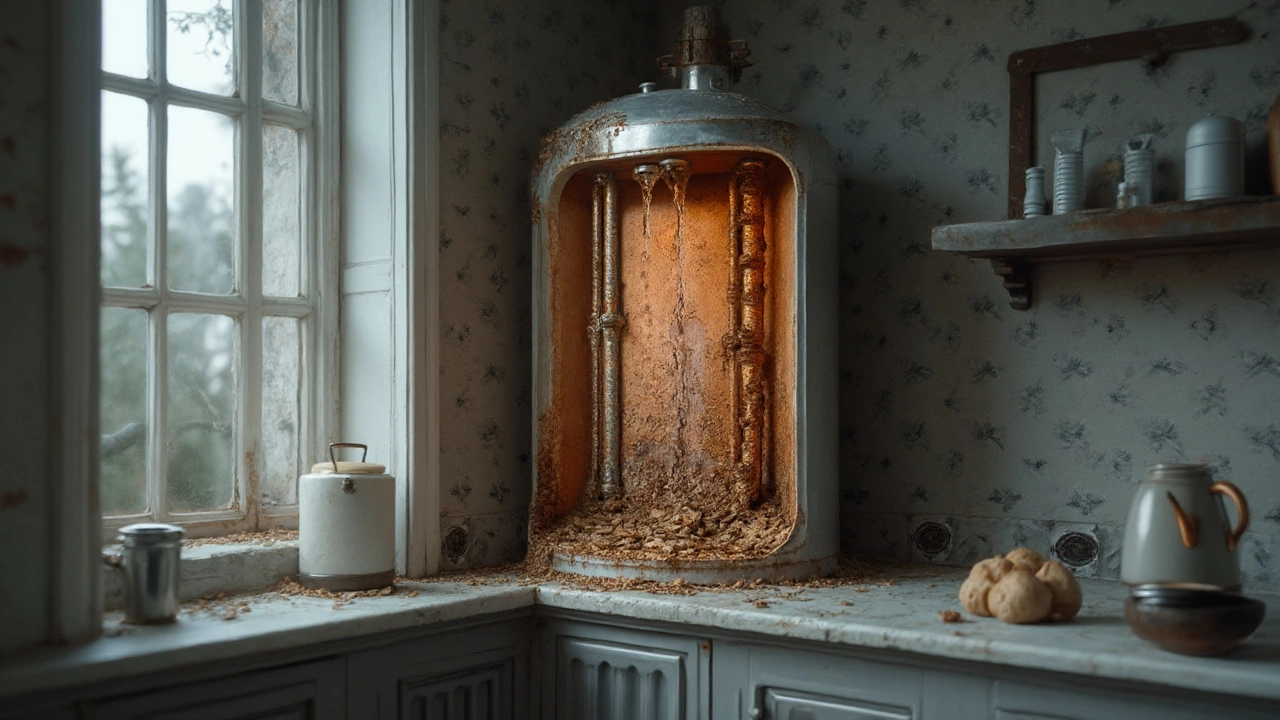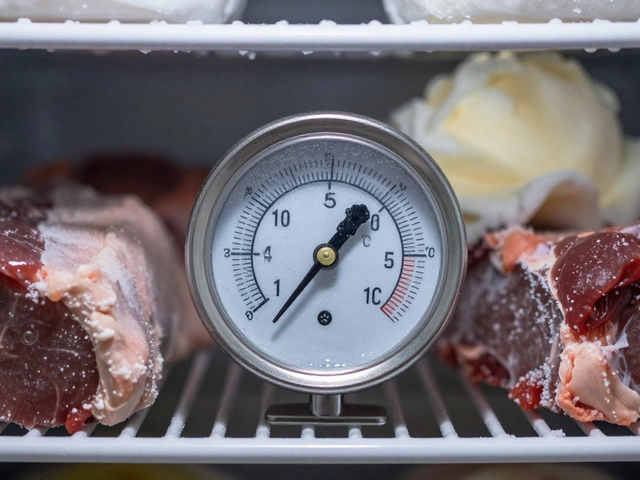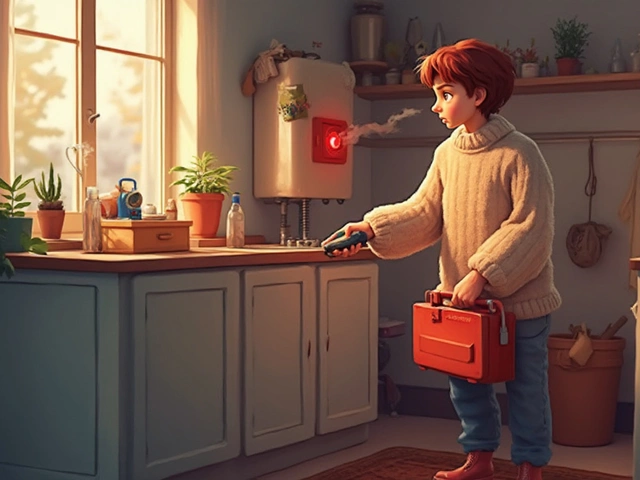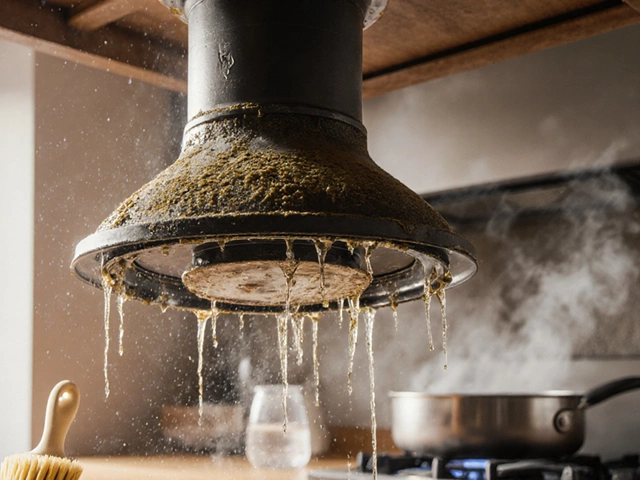Most water heater failure doesn’t happen because the unit “got old.” It happens because the tank corrodes from the inside out-usually years before it had to. The quiet villains are a spent anode rod and a bed of sediment baking at the bottom of the tank. The good news? With a simple maintenance routine that costs less than a tank of fuel, you can push replacement well into the future and avoid surprise cold showers.
- Short answer: Internal tank corrosion-caused by a depleted anode rod and sediment-is the most common reason storage water heaters fail.
- Early clues: rumbling/popping sounds, rusty water, a weeping TPR valve, and a damp base or rust streaks near fittings.
- Prevention: flush sediment, check/replace the anode every 3-5 years, control pressure, test safety valves, and keep the tank at 60°C with a tempering valve on outlets.
- System type matters: for tankless, limescale on the heat exchanger is the big killer; for heat pumps, it’s still tank corrosion if it stores water.
- Brisbane note: our water is generally soft-to-moderately hard, so scaling is moderate; tank corrosion is still the main failure risk.
The real culprit: tank corrosion (what it is, why it happens, how to spot it)
Ask any plumber who sees failed cylinders week after week: most dead storage water heaters die from internal corrosion. Manufacturers like Rheem and A.O. Smith say this plainly in their service literature: once the sacrificial anode is consumed and sediment blankets the base, the enamel tank lining can’t protect the steel and corrosion accelerates. You don’t see it until it leaks, but the failure started years earlier.
Here’s what’s going on inside a typical storage tank:
- The anode rod (magnesium or aluminium) “sacrifices” itself to corrosion so the steel tank won’t. When the anode is gone, the tank becomes the next target.
- Sediment (minerals and rust flakes) settles on the bottom. The burner or element bakes that layer, creating hot spots that stress the liner and speed corrosion. It also makes the unit noisy and less efficient.
- Excess pressure and thermal expansion hammer the tank and fittings, especially if there’s a check valve on the cold side and no expansion tank.
Evidence you can see or hear before it fails:
- Rumbling or popping when heating-classic sediment. It’s like boiling mud.
- Rusty or tea-coloured hot water that clears on cold-rust is coming from the heater.
- Dampness under the tank, orange staining around the cold/hot nipples, or a crusty ring at the base.
- A temperature-pressure relief (TPR) valve that dribbles lightly or vents often-could be excess pressure, overheating, or a failing valve.
Local context matters. Around Brisbane and much of SEQ, mains water runs soft-to-moderately hard, so scale isn’t as brutal as in parts of SA or WA. Corrosion still wins the failure race here, especially on older enamel-lined steel cylinders. Heat pump storage tanks have the same risk. Stainless steel cylinders resist corrosion better but still suffer from high pressure and poor install practices.
Safety note for Australia: AS/NZS 3500 requires storage at a minimum of 60°C to control Legionella. A tempering or mixing valve then limits outlet temperature (typically 50°C for domestic bathrooms). Never lower storage below 60°C to “save the tank.” Use a tempering valve to manage tap temperature instead.
Authoritative sources: manufacturers’ service manuals (Rheem Australia, A.O. Smith) list tank corrosion/anode depletion and sediment as primary failure causes for storage types. Plumbing codes (AS/NZS 3500) inform the safety settings that can affect stress on the tank.
Stop the failure: a simple maintenance plan you can actually keep
You don’t need a workshop and a day off to add years to a water heater’s life. You need 30-60 minutes, a hose, and either a new anode rod every few years or a licensed plumber to swap it. Here’s the plan I use at home in Brisbane and on rentals I look after.
Big picture: flush sediment quarterly or at least twice a year; check the anode every 3 years (sooner if water smells like sulfur/rotten egg); keep system pressure in check; test the TPR valve; store at 60°C with a working tempering valve.
Make it safe first.
- Electric: switch off the breaker/isolator. Gas: turn the gas control to pilot or off. Heat pump: isolate power; most have a service switch.
- Close the cold-water isolation valve to the heater.
- Let the tank cool if you’re new to this. Hot water can scald fast.
Drain a bucket to check sediment.
- Connect a garden hose to the drain valve. Run a bucket through into a drain. If you see sand-like grit or cloudy water, you’ve got sediment.
- Pro tip: if the drain valve is plastic and hasn’t moved in years, be gentle. If it weeps after, cap it with a hose cap and replace the valve later.
Flush the tank.
- Open the TPR valve briefly (lift the lever) to break vacuum, then open the drain and let water run clear. You can pulse the cold inlet on and off to stir the base. Ten minutes usually does the trick on a well-maintained tank.
- Close the drain, close the TPR, and refill before powering back up.
Check the anode rod (every 3-5 years, sooner on smelly water).
- The anode sits under a hex head on top of the tank or is part of a hot outlet nipple. You’ll often need a 27-32 mm socket and a long breaker bar.
- If the rod is under 10 mm thick, steel core showing, or coated in hard calcium, replace it. Magnesium offers strong protection; aluminium or aluminium-zinc can help with sulphide odour. Powered anodes stop smell without adding aluminium to the water.
- If you don’t have room overhead, look for a segmented/flexible anode. Many plumbers carry them for tight cupboards.
Test the TPR valve (twice a year).
- Lift the lever for 2-3 seconds. It should discharge hot water to the drain line and then reseat without dripping. If it keeps dribbling or won’t open, have it replaced. Treat TPRs with respect-they’re the last safety barrier.
Keep pressure and expansion in check.
- House pressure should typically sit around 300-500 kPa. If yours is high, ask a plumber about a pressure-reducing valve.
- If you have a non-return/check valve on the cold inlet, consider an expansion tank on the hot water line to absorb thermal expansion. It’s cheap insurance against stress on the liner and TPR.
Set temperatures correctly.
- Storage at 60°C per code, tempered to 50°C (or local requirements) at outlets. If water is scalding or slow to heat, get the tempering valve checked.
- Electric elements last longer when sediment isn’t cooking on them. Flushing really helps here.
Add a drain pan and a leak alarm if the heater sits indoors.
- A simple Wi-Fi or audible leak detector on the floor near the base can save flooring and walls. This is mandatory kit in apartments, in my opinion.
DIY vs licensed work in Australia: flushing a tank and basic checks are homeowner-friendly if you’re confident and cautious. Replacing a TPR valve, altering pipework, installing an expansion tank, or any gas work should be done by a licensed plumber/gasfitter. Replacing an anode can be DIY on electric units if you’re competent, but many Aussies sensibly book a plumber for it-seized anodes can test your patience and tools.
Costs (Brisbane ballpark, 2025):
- Anode rod part: $60-$180; installed: $250-$450.
- Flush and service call: $150-$300.
- Expansion tank installed: $250-$500.
- Tempering valve replacement: $250-$400.
Simple checklist you can save:
- Quarterly: quick flush until clear; eyeball for leaks/rust; listen for rumble.
- Twice a year: test TPR; check drain pan/leak alarm; confirm outlet temp.
- Every 3 years: pull and inspect the anode; replace if worn.
- Any time: if pressure seems high or TPR weeps, get pressure checked.
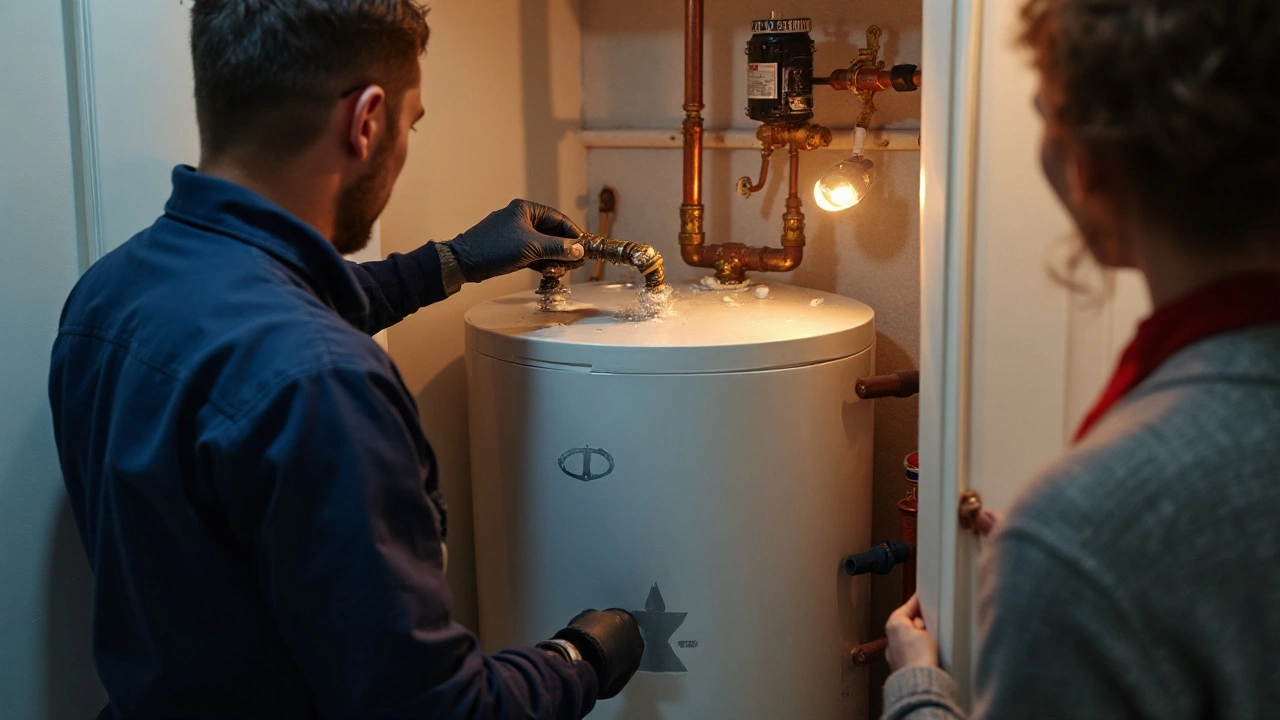
Repair or replace? Use numbers, not vibes
When a heater acts up, your wallet wants certainty. Use three questions to get there fast.
Is the tank leaking from the body? If yes, replace the unit.
- Body leaks mean the steel has perforated. No sealant or weld is a safe fix on a pressurised vessel in a home. Replace the tank.
How old is it versus typical life?
- Electric storage (enamel): 8-12 years common.
- Gas storage: 6-10 years.
- Stainless steel storage: 10-15+ years.
- Heat pump (with tank): 10-15 years.
- Instantaneous/tankless: 15-20 years with regular descaling.
What’s the repair cost versus replacement?
- 50% rule: if a repair is over half the cost of a new installed unit and the heater is past two-thirds of its expected life, lean toward replacement.
Brisbane/Australia price guide (installed, typical 2025):
- Replace like-for-like electric storage 125-250 L: ~$1,300-$2,400.
- Replace like-for-like gas storage: ~$1,800-$3,200.
- Heat pump hot water (after STCs and any promos): ~$2,500-$4,500.
- Instantaneous gas (with power point/flue upgrades as needed): ~$1,900-$3,500.
Rebates and incentives: Federal Small-scale Technology Certificates (STCs) reduce upfront costs for heat pumps and solar. Queensland sometimes runs additional rebates; these change, so check current programs before you purchase.
Simple decision path:
- Noise, slow recovery, higher bills, no leaks, unit under 8 years old: service and flush. Check anode. Replace faulty elements/thermostats as needed.
- Rusty water, heavy rumble, visible rust at fittings, 8-12 years old: price an anode and service versus new. If rust persists post-service, plan a replacement.
- TPR discharging regularly: test temperature settings; check pressure; add/replace expansion tank; replace TPR if faulty.
- Any body leak, severe external corrosion, or repeated trips: replace.
One more money tip: if you’re on off-peak tariffs (Tariff 31/33 in QLD), make sure a swap to heat pump or instantaneous still makes sense on your tariff and household pattern. Running costs shift with tariff changes.
Different heater types, quick fixes, and the questions people ask
Not all heaters fail the same way. Here’s a quick run-through by type, plus answers to the follow-ups I hear most.
Electric storage
- Most common failure: internal corrosion from anode depletion + sediment cooking the lower element.
- Quick checks: element continuity, thermostat reset, sediment flush, anode condition.
- Upgrade angle: consider stainless steel if you want longer life; still maintain pressure and anode.
Gas storage
- Most common failure: same corrosion story. Less efficient with heavy sediment because the flame bakes the base hard.
- Quick checks: burner flame quality, flue draw, thermocouple/ignition, sediment flush, anode.
- Safety: any gas smell, soot, or rollout? Call a licensed gasfitter.
Heat pump (air-source) with storage
- Common failures: tank corrosion (if steel and enamel), fan/compressor issues on older units, sensor faults.
- Quick checks: clear airflow, clean coil, check condensate drain, then the usual tank checks.
- Note: even with a heat pump, the storage tank still needs anode/sediment attention unless it’s stainless steel and anodeless by design.
Instantaneous (tankless) gas
- Most common failure: limescale choking the heat exchanger and flow sensors, especially with hard water and no scale control.
- Quick checks: descaling loop service, inlet screen cleaning, combustion analysis, and condensate clear on condensing models.
- Prevention: annual descaling where hardness is moderate/high; a scale reduction filter helps. Brisbane mains often allow longer intervals, but bore or tank water can be harsh.
Solar thermal with tank
- Common failures: tank corrosion (again), glycol issues in closed-loop systems, and valve failures.
- Quick checks: inspect collector loop, pressure, and controller; then do the same tank maintenance.
Mini‑FAQ
- Is the anode rod really that important? Yes. It’s the cheapest part doing the most work. Once it’s gone, the tank becomes the anode.
- How often should I replace the anode? Check at year 3, then every 1-2 years after that. Replace when it’s under ~10 mm thick, steel showing, or clogged with calcium.
- Magnesium or aluminium anode? Magnesium protects aggressively and is my default. Aluminium or aluminium-zinc can reduce rotten-egg smell. A powered anode fixes odour without adding metals.
- Rusty water means the tank is done, right? Not always. Flush first and test. If rust persists only on hot, the tank is likely corroding.
- My TPR valve drips. Normal? A brief discharge during heating can be normal. Constant dripping is not-could be high pressure, no expansion tank, high temperature, or a faulty TPR. Get it checked.
- What temperature should I set? In Australia: store at 60°C for hygiene and use a tempering valve to deliver safe tap temps (~50°C to bathrooms). Don’t store lower to “save” the tank.
- Do water softeners help? Softening reduces scale, great for tankless. For storage tanks, soft water can increase anode consumption-check more often.
- Can stainless steel tanks skip the anode? Many stainless models are anodeless, but pressure, temperature, and installation quality still decide lifespan. Keep pressure in range and test the TPR.
Quick troubleshooting by symptom
- No hot water (electric storage): check breaker/isolator; press reset on thermostat; test elements; flush sediment; then call a tech if no change.
- No hot water (gas storage): check pilot/ignition; gas supply; thermocouple/flame sensor; burner; sediment flush.
- Water too hot: thermostat fault or failed tempering valve-get a licensed plumber to test and replace.
- Loud banging/rumble: heavy sediment. Flush now. If noise returns quickly, plan an anode and deeper service.
- Water on the floor: trace the source. From fittings or TPR line? Serviceable. From the tank body seam? Time to replace.
Next steps (pick your situation)
- Homeowner with a noisy but not-leaking tank: do a full flush this weekend, then book an anode inspection if it’s 3+ years old.
- Landlord managing turnovers: add TPR tests and quick flushes to your routine inspections; swap anodes proactively at year 4-5 to avoid mid-lease failures.
- Apartment/indoor install: install a drain pan and a leak alarm today. One $30 sensor can save thousands.
- Considering an upgrade: compare your annual energy use and tariff with the installed cost after STCs. If your tank is over 10 years and inefficient, the maths often favours a new unit.
- On bore or very hard water: add scale control (filter or conditioning) and shorten your descaling/anode inspection intervals.
Bottom line: for storage systems, the most common failure is preventable. Keep sediment out, keep the anode alive, keep pressure in range, and your water heater will quietly get on with the job for years longer than most people expect.
